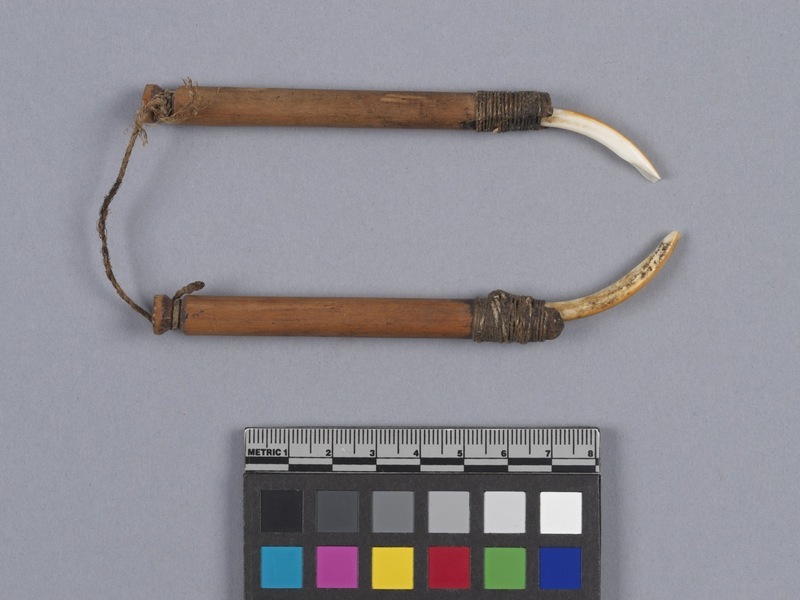Chisel Item Number: 3205/7 from the MOA: University of British Columbia

Description
Agouti tooth chisels. Cane wood makes up the shaft of the chisels, with wrapped vine thread and tree resin used to secure the teeth. The agouti rodent teeth are very sharp, strong, thin and slightly curved, coloured a light orange.The two chisels are attached by cord tied around and indentation at the ends.
History Of Use
Agoutis are tropical rainforest rodents that have very sharp, strong teeth. Their teeth are used as a chisel for making the nock at the end of arrows. To make this tool, the agouti teeth have been attached to short pieces of cane using thin, strong vines wound around one end of the teeth and an end of the cane handle that's notched with a "V". Heated tree resin is used to firmly a fix the tooth to the cane by protecting and preserving the wound thread (vine).
Cultural Context
The Yanomami are a hunter-agriculturist people who live in a northern Amazon area located on both sides of the border between Brazil and Venezuela, in the Orinoco-Amazon interfluvial region. The Yanomami had little contact with people other than neighbouring indigenous groups until the 20th century. Since the 1970s they have faced significant changes. On the Brazilian side of their territory, the Terra Indígena Yanomami was established in 1992 in the face of near-genocide. To this day, almost 60 percent of Yanomami territory is covered by mineral applications and title deeds registered in the National Department of Mineral Production in Brazil by public and private mining companies, both national and multinational. Colonization projects, implemented in the 1970s and ’80s in the east and southeast of Yanomami lands, also created a wave of land occupations that are still expanding. In addition, three military bases have been installed in Yanomami territory since 1985, leading to serious social problems among the local populations. Recently, the Yanomami created the Hutukara Yanomami Association to advocate for their rights in managing their territory and responding to the various threats to their land, in partnership with several other organizations and the states of Venezuela and Brazil.
Item History
- Made in Venezuela before 1971
- Collected during 1971
- Owned by Gillian Darling Kovanic and Rudi Kovanic before November 1, 2016
- Received from Gillian Darling Kovanic (Donor) and Rudi Kovanic (Donor) on November 1, 2016
What
- Name
- Chisel
- Identification Number
- 3205/7
- Type of Item
- chisel
- Material
- wood, agouti tooth and plant fibre
- Overall
- height 15.5 cm, width 5.0 cm, depth 1.2 cm
Who
- Culture
- Yanomami
- Previous Owner
- Gillian Darling Kovanic and Rudi Kovanic
- Received from
- Gillian Darling Kovanic (Donor) and Rudi Kovanic (Donor)
Where
- Holding Institution
- MOA: University of British Columbia
- Made in
- Venezuela
When
- Creation Date
- before 1971
- Collection Date
- during 1971
- Ownership Date
- before November 1, 2016
- Acquisition Date
- on November 1, 2016
Other
- Condition
- fair
- Accession Number
- 3205/0007